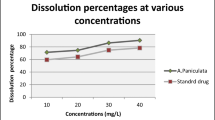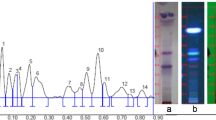Abstract
The present investigation is focused on exploring the anti-urolithiatic potential of aqueous leaf extract of Tragia involucrata (TIA) and its silver nanoparticles (AgNPs) and to quantify the total phenol, flavonoid, terpenoid and sterol contents present in TIA. Quantification results suggested TIA to be a rich source of phenol, flavonoid and terpenoid and less of sterol content. The AgNPs were synthesized by a simple green method using aqueous extract of T. involucrata. The formation of AgNPs was confirmed through UV spectroscopy, particle size analysis, zeta potential, X-ray diffraction and transmission electron microscopy. The in vitro struvite growth inhibitory activity of the extract was performed using a single gel diffusion method. Samples incorporated with higher concentration of 2% TIA and AgNPs (200 μg mL−1) exhibited potent crystal growth inhibitory activity which was further supported by the dissolution of crystals in gel medium. Calcium oxalate stone formation was induced in rats by the oral administration of ethylene glycol in water. Stone formation was assessed by increase in the levels of calcium and phosphorous in the urine and accumulation of nitrogenous substances like urea, creatinine in renal tissues and blood. Prophylactic treatment with TIA and AgNPs showed significant anti-urolithiatic activity with normalization of the mineral contents of the urine and serum samples. Histopathological analysis of the kidney of TIA- and AgNP-treated animals showed no CaOx deposits and a normal architecture of the kidney cells. We conclude that aqueous extract of T. involucrata and its AgNPs has potential for the treatment of patients with recurrent stones.






Similar content being viewed by others
References
De-Yoreo JJ, Qiu SR, Hoyer JR. Molecular modulation of calcium oxalate crystallization. Am J Physiol Renal Physiol. 2006;291:1123–31.
Chauhan CK, Joshi MJ. Growth inhibition of struvite crystals in the presence of juice of Citrus medica Linn. Urol Res. 2008;36:265–8.
Chauhan CK, Joshi MJ. In vitro crystallization, characterization and growth-inhibitory study of urinary type struvite crystals. J Crystal Growth. 2013;362:330–7.
Bichler KH, Eipper E, Naber K, Braun V, Zimmermann R, Lahme S. Urinary infection stones. Int J Antimicrob Agents. 2002;19:488–98.
Tsujihata M. Mechanism of calcium oxalate renal stone formation and renal tubular cell injury. Int J Urol. 2008;15:115–20.
Basavaraj DR, Biyani CS, Browning AJ, Cartledge JJ. The role of urinary kidney stone inhibitors and promoters in the pathogenesis of calcium containing renal stones. EAU-EBU Update Series. 2007;5:126–36.
Micali S, Grande M, Sighinolfi MC, De Came C, De Stefani S, Bianchi G. Medical therapy of urolithiasis. J Endourol. 2006;20:841–7.
Mc Acteer JA, Evan AP. The acute and long-term adverse effects of shock wave lithotripsy. Semin Nephrol. 2008;28:200–13.
Aswathi R, Pant I, Kulkarni G, Kikuchi IS, Pinto TA, Dua K, Malipeddi RV. Opportunities and challenges in nano-structure mediated drug delivery: where do we stand? Curr Nanomed. 2016;6:78–104.
Madan JR, Ghuge NP, Dua K. Formulation and evaluation of proniosomes containing lornoxicam. Durg Deliv Transl Res. 2016;6:511–8.
Madan JR, Khude PA, Dua K. Development and evaluation of solid lipid nanoparticles of Mometasone furoate for topical delivery. Int J Pharm Investig. 2014;4:60–4.
Swathy B. A review on metallic silver nanoparticles. IOSR J Pharm. 2014;4:38–44.
Nel A. Toxic potential of materials at the nano level. Sci. 2006;311:622–7.
Kumari A, Guliani A, Singla R, Yadav R, Yadav SK. Silver nanoparticles synthesised using plant extracts show strong antibacterial activity. IET Nanobiotechnol. 2015;9:142–52.
Nayak D, Ashe S, Rauta RP, Nayak B. Biosynthesis, characterisation and antimicrobial activity of silver nanoparticles using Hibiscus rosa-sinensis petals extracts. IET Nanobiotechnol. 2015;9:288–93.
Ahmed S, Saifullah, Babu LS. Green synthesis of silver nanoparticles using Azadirachta indica. J Radiat Res Appl Sci 2016; 9: 1–7.
WHO. WHO traditional Medicine Strategy 2002–2005. World Health Organisation document. WHO/EDM/TRM/20021. World Health Organisation, Geneva; 2002.
Satish H, Raman D, Kashama D, Shivananda BG, Shridhar KA. In vitro anti-lithatic activity study of Tribulus terrestris fruits and Boerhaavia diffusa roots. Pharm Lett. 2010;2:12–20.
Novaes Ada S, Mota DJ, Barison A, Veber CL, Negrao FJ, Kassuya CA, de Barros ME. Diuretic and antilithiasis activities of ethanolic extract from Piper amalago (Piperaceae). Phytomedicine. 2014;21:523–8.
Bayir Y, Halici Z, Keles MS, Colak S, Cakir A, Kaya Y, Akcay F. Helichrysum plicatum DC. sub. sp. plicatum extract as a preventive agent in experimentally induced urolithiasis model. J Ethnopharmacol. 2011;138:408–14.
Joshi CG, Gopal M, Kumari NS. Antitumor activity of hexane and ethyl acetate extracts of aerial parts of Tragia involucrata Linn. Int J Cancer Res. 2011;7:267–77.
Farook MS, Atlee CW. Antidiabetic and hypolipidemic potential of Tragia involucrata Linn in Streptozotocin-nicotinamide induced type ii diabetic rats. Int J Pharm Pharm Sci. 2011;3:103–9.
Samy RP, Gopalakrishnakone P, Sarumathi M, Ignacimuthu S. Wound healing potential of Tragia involucrata extract in rats. Fitoterapia. 2006;77:300–2.
Palani S, Nirmal S, Gokulan R. Evaluation of nephroprotective and antioxidant potential of Tragia involucrata. Drug Invent. 2009;1:55–8.
Saniasiaya J, Salim R, Mohamad I, Harun A. Antifungal effect of Malaysian Aloe vera leaf extract on selected fungal species of pathogenic otomycosis species in in vitro culture medium. Oman Med J. 2017;32:41–6.
Meshram GG, Kumar A, Rizvi W, Tripathi CD, Khan RA. Evaluation of the anti-inflammatory activity of the aqueous and ethanolic extracts of the leaves of Albizzia lebbeck in rats. J Tradit Complement Med 2015; 6:172–175.
Goswami N, Chatterjee S. Assessment of free radical scavenging potential and oxidative DNA damage preventive activity of Trachyspermum ammi L. (carom) and Foeniculum vulgare Mill. (fennel) seed extracts. Biomed Res Int. 2014; doi:10.1155/2014/582767.
Harborne JB. Phytochemical methods: a guide to modern techniques of plant analysis. 2nd ed. New York: Chapman and Hall; 1984.
Das M, Himaja M, Nambiraj AN, Rajan R. Phytochemical analysis, antioxidant and in vitro growth inhibition of struvite crystals by Ipomoea eriocarpa leaf extracts. J Food Bio Chem. 2016;40:148–60.
Kumar HA, Mandal BK, Kumar K, Maddinedi SB, Sai Kumar T, Madhiyazhagan P, Ghosh AR. Antimicrobial and antioxidant activities of Mimusops elengi seed extract mediated isotropic silver nanoparticles. Spectrochim Acta A Mol Biomol Spectrosc. 2014;130:13–8.
Das M, Himaja M. Antiurolithiatic activity of ethanol leaf extract of Ipomoea eriocarpa against ethylene glycol induced urolithiasis in male wistar rats. Indian J Pharmacol. 2016;48:270–4.
Dhara AK, Suba V, Sen T, Pal S, Nag Chaudhuri AK. Preliminary studies on the anti-inflammatory and analgesic activity of the methanolic fraction of the root extract of Tragia involucrata Linn. J Ethnopharmacol. 2000;72:265–8.
Al Anazi SA, Jamir Anwar MD, Afroz Ahmad MD. Hepatoprotective and antioxidant activity of Tragia involucrata root extracts against CCl4 induced hepatotoxicity in rats. Pharm Lett. 2015;7:146–52.
Venkat Rao N, Benoy K, Hemamalini K, Shanta Kumar SM, Satyanarayana S. Pharmacological evaluation of root extracts of Tragia involucrata. Pharmacologyonline. 2007;2:236–44.
Tiwari DK, Jin T, Behari J. Dose-dependent in vivo toxicity assesment of silver nanoparticle in wistar rats. Toxicol Mech Methods. 2011;21:13–24.
Pavlovschi I, Goncear V, Scutari C. Chronic toxicity of silver nanoparticles. In: Sontea V, Tiginyanu I, editors. IFMBE Proceedings: 3rd International Conference on Nanotechnologies and Biomedical Engineering. Singapore: Springer; 2015. p. 23–6.
Dua K, Malipeddi VR, Madan J, Gupta G, Chakravarthi S, Aswathi R, Kikuchi IS, Pinto TA. Norfloxacin and metronidazole topical formulations for effective treatment of bacterial infections and burn wounds. Interv Med Appl Sci. 2016;8:68–76.
Dua K, Chakravarthi S, Kumar D, Sheshala R, Gupta G. Formulation, characterization, in vitro, in vivo, and histopathological evaluation of transdermal drug delivery containing norfloxacin and Curcuma longa. Int J Pharm Investig. 2013;3:183–7.
Song JY, Kim BS. Rapid biological synthesis of silver nanoparticles using plant leaf extracts. Bioprocess Biosyst Eng. 2009;32:79–84.
Banerjee P, Satapathy M, Mukhopahayay A, Das P. Leaf extract mediated green synthesis of silver nanoparticles from widely available Indian plants: synthesis, characterization, antimicrobial property and toxicity analysis. Bioresour Bioprocessing. 2014;1:1–10.
Tania A, Cristina DD, Ana Paula SM, Maria L, Antonio L, Caden S. Evaluation of the antiurolithiatic activity of the extract of Costus spiralis roscoe in rats. J Ethnopharmacol. 1999;66:193–8.
Panigrahi NP, Dey S, Sahoo M, Choudhary SS, Mahajan S. Alteration in oxidative/nitrosative imbalance, histochemical expression of osteopontin and antiurolithiatic efficacy of Xanthium strumarium (L.) in ethylene glycol induced urolithiasis. Biomed Pharmacother. 2016;84:1524–32.
Bouanani S, Henchiri C, Migianu-Griffoni E, Aouf N, Lecouvey M. Pharmacological and toxicological effects of Paronychia argentea in experimental calcium oxalate nephrolithiasis in rats. J Ethnopharmacol. 2010;129:38–45.
Marshall RW, Cochran M, Hodgkinson A. Relationships between calcium and oxalic acid intake in the diet and their excretion in the urine of normal and renal-stone-forming subjects. Clin Sci. 1972;43:91–9.
Divakar K, Pawar TA, Chandrasekhar SB, Dighe SB, Divakar G. Protective effect of the hydro-alcoholic extract of Rubia cordifolia roots against ethylene glycol induced urolithiasis in rats. Food Chem Toxicol. 2010;48:1013–8.
Acknowledgements
The authors are thankful to VIT University, Vellore, India, for providing financial support and necessary facilities required to perform the work. The authors are grateful to P.B Histopathology Lab, Chennai, India, for carrying out the histopathology studies and RM Medical Centre and Hospital, Vellore, India, for performing the biochemical analysis of the urine and serum samples.
Author information
Authors and Affiliations
Corresponding author
Ethics declarations
ᅟ
All institutional and national guidelines for the care and use of laboratory animals were followed.
Conflict of interest
The authors declare that they have no conflict of interest.
Rights and permissions
About this article
Cite this article
Velu, V., Das, M., Raj N, A. et al. Evaluation of in vitro and in vivo anti-urolithiatic activity of silver nanoparticles containing aqueous leaf extract of Tragia involucrata . Drug Deliv. and Transl. Res. 7, 439–449 (2017). https://doi.org/10.1007/s13346-017-0363-x
Published:
Issue Date:
DOI: https://doi.org/10.1007/s13346-017-0363-x




